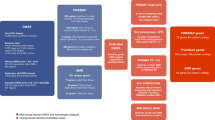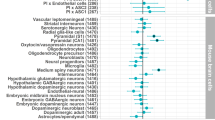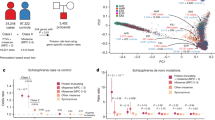Abstract
Susceptibility to schizophrenia and bipolar disorder may involve a substantial, shared contribution from thousands of common genetic variants, each of small effect. Identifying whether risk variants map to specific molecular pathways is potentially biologically informative. We report a molecular pathway analysis using the single-nucleotide polymorphism (SNP) ratio test, which compares the ratio of nominally significant (P<0.05) to nonsignificant SNPs in a given pathway to identify the ‘enrichment’ for association signals. We applied this approach to the discovery (the International Schizophrenia Consortium (n=6909)) and validation (Genetic Association Information Network (n=2729)) of schizophrenia genome-wide association study (GWAS) data sets. We investigated each of the 212 experimentally validated pathways described in the Kyoto Encyclopaedia of Genes and Genomes in the discovery sample. Nominally significant pathways were tested in the validation sample, and five pathways were found to be significant (P=0.03–0.001); only the cell adhesion molecule (CAM) pathway withstood conservative correction for multiple testing. Interestingly, this pathway was also significantly associated with bipolar disorder (Wellcome Trust Case Control Consortium (n=4847)) (P=0.01). At a gene level, CAM genes associated in all three samples (NRXN1 and CNTNAP2), which were previously implicated in specific language disorder, autism and schizophrenia. The CAM pathway functions in neuronal cell adhesion, which is critical for synaptic formation and normal cell signaling. Similar pathways have also emerged from a pathway analysis of autism, suggesting that mechanisms involved in neuronal cell adhesion may contribute broadly to neurodevelopmental psychiatric phenotypes.
This is a preview of subscription content, access via your institution
Access options
Subscribe to this journal
Receive 12 print issues and online access
$259.00 per year
only $21.58 per issue
Buy this article
- Purchase on Springer Link
- Instant access to full article PDF
Prices may be subject to local taxes which are calculated during checkout

Similar content being viewed by others
References
Stefansson H, Rujescu D, Cichon S, Pietilainen OP, Ingason A, Steinberg S et al. Large recurrent microdeletions associated with schizophrenia. Nature 2008; 455: 232–236.
O’Donovan MC, Craddock N, Norton N, Williams H, Peirce T, Moskvina V et al. Identification of loci associated with schizophrenia by genome-wide association and follow-up. Nat Genet 2008; 40: 1053–1055.
International Schizophrenia Consortium. Rare chromosomal deletions and duplications increase risk of schizophrenia. Nature 2008; 455: 237–241.
International Schizophrenia Consortium. Common polygenic variation contributes to risk of schizophrenia that overlaps with bipolar disorder. Nature 2009; 460: 748–752 (in press).
Lichtenstein P, Yip BH, Bjork C, Pawitan Y, Cannon TD, Sullivan PF et al. Common genetic determinants of schizophrenia and bipolar disorder in Swedish families: a population-based study. Lancet 2009; 373: 234–239.
Lesnick TG, Papapetropoulos S, Mash DC, Ffrench-Mullen J, Shehadeh L, de Andrade M et al. A genomic pathway approach to a complex disease: axon guidance and Parkinson disease. PLoS Genet 2007; 3: e98.
Askland K, Read C, Moore J . Pathways-based analyses of whole-genome association study data in bipolar disorder reveal genes mediating ion channel activity and synaptic neurotransmission. Hum Genet 2008; 125: 63–79.
Subramanian A, Tamayo P, Mootha VK, Mukherjee S, Ebert BL, Gillette MA et al. Gene set enrichment analysis: a knowledge-based approach for interpreting genome-wide expression profiles. Proc Natl Acad Sci USA 2005; 102: 15545–15550.
Wang K, Li M, Bucan M . Pathway-based approaches for analysis of genome-wide association studies. Am J Hum Genet 2007; 81: 1278–1283.
O’Dushlaine C, Kenny E, Segurado R, Heron E, Morris D, Corvin A . The SNP ratio test: pathway mining of genome-wide association datasets. Bioinformatics 2009; 25: 2762–2763 (in press).
Holmans P, Green EK, Phawa JS, Ferreira MA, Purcell SM, Sklar P et al. Gene ontology analysis of GWAS study data sets provides insights into the biology of bipolar disorder. Am J Hum Genet 2009; 85: 13–24.
Hong MG, Pawitan Y, Magnusson PK, Prince JA . Strategies and issues in the detection of pathway enrichment in genome-wide association studies. Hum Genet 2009; 126: 1348–1354.
Kyoto Encyclopaedia of Genes and Genomes. (http://www.genome.ad.jp/kegg/pathway.html).
Genetic Association Information Network. (http://www.ncbi.nlm.nih.gov/projects/gap/cgi-bin/study.cgi?study_id=phs000021.v2.p1).
Suarez BK, Duan J, Sanders AR, Hinrichs AL, Jin CH, Hou C et al. Genome-wide linkage scan of 509 European-ancestry and African American families with schizophrenia: suggestive evidence of linkage at 8p23.3-p21.2 and 11p.13.1-q14.1 in the combined sample. Am J Hum Genet 2006; 78: 315–333.
Wellcome Trust Case Control Consortium. Genome-wide association study of 14 000 cases of seven common disease and 3000 shared controls. Nature 2007; 447: 661–678.
Psychiatric GWAS Consortium Coordinating Committee, Cichon S, Craddock N, Daly M, Faraone SV, Gejman PV, Kelsoe J et al. Genome-wide association studies: history, rationale, and prospects for psychiatric disorders. Am J Psychiatry 2009; 166: 540–556.
Kang Y, Zhang X, Dobie F, Wu H, Craig AM . Induction of GABAergic postsynaptic differentiation by alpha-neurexins. J Biol Chem 2008; 283: 2323–2334.
Croning MD, Marshall MC, McLaren P, Armstrong JD, Grant SG . G2Cdb: the Genes to Cognition database. Nucleic Acids Res 2009; 37: D846–D851.
Wang K, Zhang H, Deqiong M, Bucan M, Glessner JT, Abrahams BS et al. Common genetic variants on 5q14.1 associate with autistic spectrum disorders. Nature (in press).
Kirov G, Gumus D, Chen W, Norton N, Georgieva L, Sari M et al. Comparative genome hybridization suggests a role for NRXN1 and APBA2 in schizophrenia. Hum Mol Genet 2008; 17: 458–465.
Rujescu D, Ingason A, Cichon S, Pietilainen OP, Barnes MR, Toulopoulou T et al. Disruption of the neurexin 1 gene is associated with schizophrenia. Hum Mol Genet 2009; 18: 988–996.
Walsh T, McClellan JM, McCarthy SE, Addington AM, Pierce SB, Cooper GM et al. Rare structural variants disrupt multiple genes in neurodevelopmental pathways in schizophrenia. Science 2008; 320: 539–543.
Marshall CR, Noor A, Vincent JB, Lionel AC, Feuk L, Skaug J et al. Structural variation of chromosomes in autism spectrum disorder. Am J Hum Genet 2008; 82: 477–488.
Szatmari P, Paterson AD, Zwaigenbaum L, Roberts W, Brian J, Liu XQ et al. Mapping autism risk loci using genetic linkage and chromosomal rearrangements. Nat Genet 2007; 39: 319–328.
Vernes SC, Newbury DF, Abrahams BS, Winchester L, Nicod J, Groszer M et al. A functional genetic link between distinct developmental language disorders. N Engl J Med 2008; 359: 2337–2345.
Alarcon M, Abrahams BS, Stone JL, Duvall JA, Perederiy JV, Bomar JM et al. Linkage, association, and gene-expression analyses identify CNTNAP2 as an autism-susceptibility gene. Am J Hum Genet 2008; 82: 150–159.
Arking DE, Cutler DJ, Brune CW, Teslovich TM, West K, Ikeda M et al. A common genetic variant in the neurexin superfamily member CNTNAP2 increases familial risk of autism. Am J Hum Genet 2008; 82: 160–164.
Bakkaloglu B, O’Roak BJ, Louvi A, Gupta AR, Abelson JF, Morgan TM et al. Molecular cytogenetic analysis and resequencing of contactin associated protein-like 2 in autism spectrum disorders. Am J Hum Genet 2008; 82: 165–173.
Friedman JI, Vrijenhoek T, Markx S, Janssen IM, van der Vliet WA, Faas BH et al. CNTNAP2 gene dosage variation is associated with schizophrenia and epilepsy. Mol Psychiatry 2008; 13: 261–266.
Cohen AR, Woods DF, Marfatia SM, Walther Z, Chishti AH, Anderson JM . Human CASK/LIN-2 binds syndecan-2 and protein 4.1 and localizes to the basolateral membrane of epithelial cells. J Cell Biol 1998; 142: 129–138.
Setou M, Nakagawa T, Seog DH, Hirokawa N . Kinesin superfamily motor protein KIF17 and mLin-10 in NMDA receptor-containing vesicle transport. Science 2000; 288: 1796–1802.
Chan JR, Jolicoeur C, Yamauchi J, Elliott J, Fawcett JP, Ng BK et al. The polarity protein Par-3 directly interacts with p75NTR to regulate myelination. Science 2006; 314: 832–836.
Zhang H, Macara IG . The polarity protein PAR-3 and TIAM1 cooperate in dendritic spine morphogenesis. Nat Cell Biol 2006; 8: 227–237.
Shen Y, Li N, Wu S, Zhou Y, Shan Y, Zhang Q et al. Nudel binds Cdc42GAP to modulate Cdc42 activity at the leading edge of migrating cells. Dev Cell 2008; 14: 342–353.
Hill JJ, Hashimoto T, Lewis DA . Molecular mechanisms contributing to dendritic spine alterations in the prefrontal cortex of subjects with schizophrenia. Mol Psychiatry 2006; 11: 557–566.
Mao Y, Ge X, Frank CL, Madison JM, Koehler AN, Doud MK et al. Disrupted in schizophrenia 1 regulates neuronal progenitor proliferation via modulation of GSK3beta/beta-catenin signaling. Cell 2009; 136: 1017–1031.
Ohtsubo K, Marth JD . Glycosylation in cellular mechanisms of health and disease. Cell 2006; 126: 855–867.
Weinhold B, Seidenfaden R, Röckle I, Mühlenhoff M, Schertzinger F, Conzelmann S et al. Genetic ablation of polysialic acid causes severe neurodevelopmental defects rescued by deletion of the neural cell adhesion molecule. J Biol Chem 2005; 280: 42971–42977.
Angata K, Chan D, Thibault J, Fukuda M . Molecular dissection of the ST8Sia IV polysialyltransferase. Distinct domains are required for neural cell adhesion molecule recognition and polysialylation. J Biol Chem 2004; 279: 25883–25890.
Willer CJ, Sanna S, Jackson AU, Scuteri A, Bonnycastle LL, Clarke R et al. Newly identified loci that influence lipid concentrations and risk of coronary artery disease. Nat Genet 2008; 40: 161–169.
Elbers C, van Eijk KR, Franke L, Mulder F, van der Schouw YT, Wijmenga C et al. Using genome-wide pathway analysis to unravel the aetiology of complex diseases. Genet Epidemiol 2009; 33: 419–431.
Acknowledgements
We thank all the participating patients, institutions and medical staff, without whose contribution this work would not have been possible. We acknowledge the support of our funders, in particular Science Foundation Ireland and the Health Research Board. We appreciate the useful comments made by anonymous reviewers.
Author information
Authors and Affiliations
Consortia
Corresponding author
Additional information
Supplementary Information accompanies the paper on the Molecular Psychiatry website (http://www.nature.com/mp)
Supplementary information
Appendix
Appendix
The International Schizophrenia Consortium: Trinity College Dublin—Derek W Morris, Colm T O’Dushlaine, Elaine Kenny, Emma M Quinn, Michael Gill, Aiden Corvin; Cardiff University—Michael C O’Donovan, George K Kirov, Nick J Craddock, Peter A Holmans, Nigel M Williams, Lucy Georgieva, Ivan Nikolov, N Norton, H Williams, Draga Toncheva, Vihra Milanova, Michael J Owen; Karolinska Institutet/University of North Carolina at Chapel Hill—Christina M Hultman, Paul Lichtenstein, Emma F Thelander, Patrick Sullivan; University College London—Andrew McQuillin, Khalid Choudhury, Susmita Datta, Jonathan Pimm, Srinivasa Thirumalai, Vinay Puri, Robert Krasucki, Jacob Lawrence, Digby Quested, Nicholas Bass, Hugh Gurling; University of Aberdeen—Caroline Crombie, Gillian Fraser, Soh Leh Kuan, Nicholas Walker, David St Clair; University of Edinburgh—Douglas HR Blackwood, Walter J Muir, Kevin A McGhee, Ben Pickard, Pat Malloy, Alan W Maclean, Margaret Van Beck; Queensland Institute of Medical Research—Naomi R Wray, Peter M Visscher, Stuart Macgregor; University of Southern California—Michele T Pato, Helena Medeiros, Frank Middleton, Celia Carvalho, Christopher Morley, Ayman Fanous, David Conti, James A Knowles, Carlos Paz Ferreira, Antonio Macedo, M Helena Azevedo, Carlos N Pato; Massachusetts General Hospital—Jennifer L Stone, Douglas M Ruderfer, Manuel AR Ferreira, Stanley Center for Psychiatric Research and Broad Institute of MIT and Harvard—Shaun M Purcell, Jennifer L Stone, Kimberly Chambert, Douglas M Ruderfer, Finny Kuruvilla, Stacey B Gabriel, Kristin Ardlie, Mark J Daly, Edward M Scolnick, Pamela Sklar.
Rights and permissions
About this article
Cite this article
O'Dushlaine, C., Kenny, E., Heron, E. et al. Molecular pathways involved in neuronal cell adhesion and membrane scaffolding contribute to schizophrenia and bipolar disorder susceptibility. Mol Psychiatry 16, 286–292 (2011). https://doi.org/10.1038/mp.2010.7
Received:
Revised:
Accepted:
Published:
Issue Date:
DOI: https://doi.org/10.1038/mp.2010.7
Keywords
This article is cited by
-
NoRCE: non-coding RNA sets cis enrichment tool
BMC Bioinformatics (2021)
-
SLC1A3 C3590T but not BDNF G196A is a predisposition factor for stress as well as depression, in an adolescent eastern Indian population
BMC Medical Genetics (2020)
-
Reduced levels of circulating adhesion molecules in adolescents with early-onset psychosis
npj Schizophrenia (2020)
-
In the line-up: deleted genes associated with DiGeorge/22q11.2 deletion syndrome: are they all suspects?
Journal of Neurodevelopmental Disorders (2019)
-
Phototransduction and circadian entrainment are the key pathways in the signaling mechanism for the baculovirus induced tree-top disease in the lepidopteran larvae
Scientific Reports (2018)



